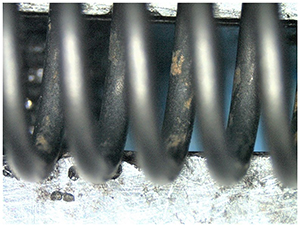
Posted to News on 3rd Nov 2021, 00:00
The signs your springs are about to fail
Corrosion is the deterioration of a metal surface because of an electrochemical process between it and the surrounding environment. But while this is a good definition of what corrosion is, it does not explain why this is a problem for springs. Interestingly, corrosion is not usually the sole cause for failure. Rather, it creates pits on the surface which act as stress concentration points, resulting in a premature fatigue failure. Corrosion can also lead to embrittlement of the material, causing catastrophic failure.

When we receive a broken spring, we visually examine it by eye for any obvious signs and clues of a failure method. Corrosion is usually fairly easy to see, as there is typically some discolouration of the wire’s surface. Corrosion is also identifiable by surface pitting – holes created on the surface of the wire by a corrosive substance. Pits can be small or large, depending on the length of exposure, the amount, and the strength of the corrosive substance present.
Once the initial examination, and once the this has been completed, it’s time to move to the microscopes for a more detailed view. Initially, the microscope allows us to look at the surface of the spring under low magnification. The entire spring is examined, and this will indicate if the corrosion is widespread or localised to smaller areas. We also check to see if there is any substance left on the spring or damage to the region. Residual substances could be from oil or cleaning products, both of which could give us an idea of why the corrosion started. Localised damage, scratches, etc, are also identified; these could remove any corrosion protection, accelerating corrosion.
After the severity of pitting has been identified, we can aim the analysis to more focused areas. Close-up images, especially around the initiation, are taken so that our final report can be as informative as possible, allowing our client to see the problem areas.
The next stage is to mount and polish small samples cut from the failed spring; one piece is cut and mounted in the transverse orientation, the other being longitudinal. Once polished to a one micron level, the sample is examined under a second microscope. Focusing on the edge of the specimen, we are looking for surface pits, again determining the extent of the corrosion. These look like tree branches initiating from the outside diameter, moving inwards.
Final examinations include SEM and EDX analyses. These will help us give our final determination on whether corrosion has occurred. SEM imaging allows us to get highly magnified images of the initiation to identify pits clearly. EDS analysis tells us if there are any contaminating elements consistent with corrosion, such as chlorine, sodium and/or high concentrations of oxygen.
Why corrosion occurs
Many reasons encourage corrosion to occur on a spring, and some are more common than others. Factors such as temperature, humidity, and contaminants all have a significant impact on the material.
The most common reason is due to the storage of either the material or the springs themselves. The environment in which springs are stored is critical. If raw material or a spring is stored in a humid area with significant temperature variations, condensation can form, reacting with the surface, causing oxidisation.
Something often overlooked is highly corrosive cleaning solutions, such as bleach and floor cleaning agents. If a storage area is cleaned using solutions such as these and they come into contact with the spring material, it could cause the material to start corroding. Further contact between two conflicting metals in the presence of an electrolyte can accelerate corrosion and cause premature failure of springs.
A spring’s surrounding atmosphere, such as coastlines, can also cause accelerated corrosion rates because the atmosphere holds salt from the sea. Likewise, for puddles, if they splash onto the springs regularly, this could cause corrosion to initiate. Even springs working within an oil environment can corrode if the working oil is contaminated with another solution, such as water.
Springs can be designed to operate in corrosive environments. But without proper materials and manufacturing methods, or coatings, such as powder coating, tailored for the environment in which they will be working, corrosion will still occur. Furthermore, if the springs material is open to the environment due to the coating being damaged or peeling, it could encourage decay in those damaged areas.
To summarise, it’s essential to consider storage, working environments and protective coatings when designing and working with springs. Reducing exposure to contaminants will help reduce failures and improve a spring’s life cycle.










